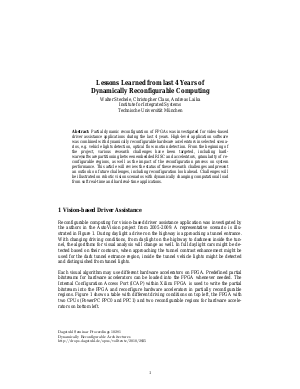Lessons Learned from last 4 Years of Reconfigurable Computing
Authors Walter Stechele, Christopher Claus, Andreas Laika
-
Part of:
Volume:
Dagstuhl Seminar Proceedings, Volume 10281
Part of: Series: Dagstuhl Seminar Proceedings (DagSemProc) - License:
 Creative Commons Attribution 4.0 International license
Creative Commons Attribution 4.0 International license
- Publication Date: 2010-12-14
File

PDF
DagSemProc.10281.8.pdf
- Filesize: 177 kB
- 7 pages
Document Identifiers
Subject Classification
Keywords
- Reconfigurable computing
- vision-based driver assistance
Metrics
- Access Statistics
-
Total Accesses (updated on a weekly basis)
0PDF Downloads0Metadata Views
Abstract
Partial dynamic reconfiguration of FPGAs was investigated for video-based driver assistance applications during the last 4 years. High-level application software was combined with dynamically reconfigurable hardware accelerators in selected scenarios, e.g. vehicle lights detection, optical flow motion detection. From the beginning of the project, various research challenges have been targeted, including hardware/software partitioning between embedded RISC and accelerators, granularity of reconfigurable regions, as well as the impact of the reconfiguration process on system performance. This article will review the status of these research challenges and present an outlook on future challenges, including reconfiguration look ahead. Challenges will be illustrated on robotic vision scenarios with dynamically changing computational load from soft real-time and hard real-time applications.
Cite As Get BibTex
Walter Stechele, Christopher Claus, and Andreas Laika. Lessons Learned from last 4 Years of Reconfigurable Computing. In Dynamically Reconfigurable Architectures. Dagstuhl Seminar Proceedings, Volume 10281, pp. 1-7, Schloss Dagstuhl – Leibniz-Zentrum für Informatik (2010)
https://doi.org/10.4230/DagSemProc.10281.8
BibTex
@InProceedings{stechele_et_al:DagSemProc.10281.8,
author = {Stechele, Walter and Claus, Christopher and Laika, Andreas},
title = {{Lessons Learned from last 4 Years of Reconfigurable Computing}},
booktitle = {Dynamically Reconfigurable Architectures},
pages = {1--7},
series = {Dagstuhl Seminar Proceedings (DagSemProc)},
ISSN = {1862-4405},
year = {2010},
volume = {10281},
editor = {Peter M. Athanas and J\"{u}rgen Becker and J\"{u}rgen Teich and Ingrid Verbauwhede},
publisher = {Schloss Dagstuhl -- Leibniz-Zentrum f{\"u}r Informatik},
address = {Dagstuhl, Germany},
URL = {https://drops.dagstuhl.de/entities/document/10.4230/DagSemProc.10281.8},
URN = {urn:nbn:de:0030-drops-28352},
doi = {10.4230/DagSemProc.10281.8},
annote = {Keywords: Reconfigurable computing, vision-based driver assistance}
}
